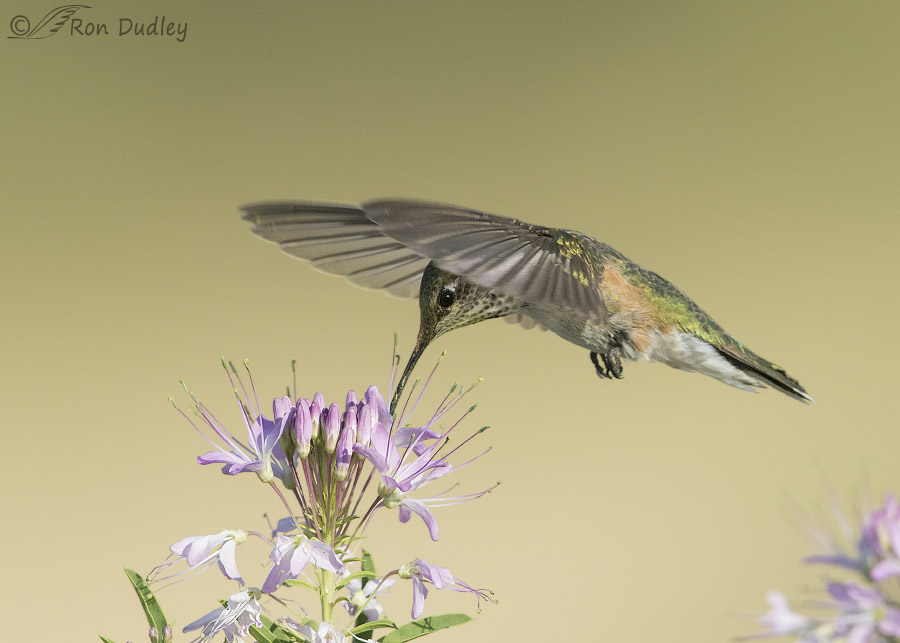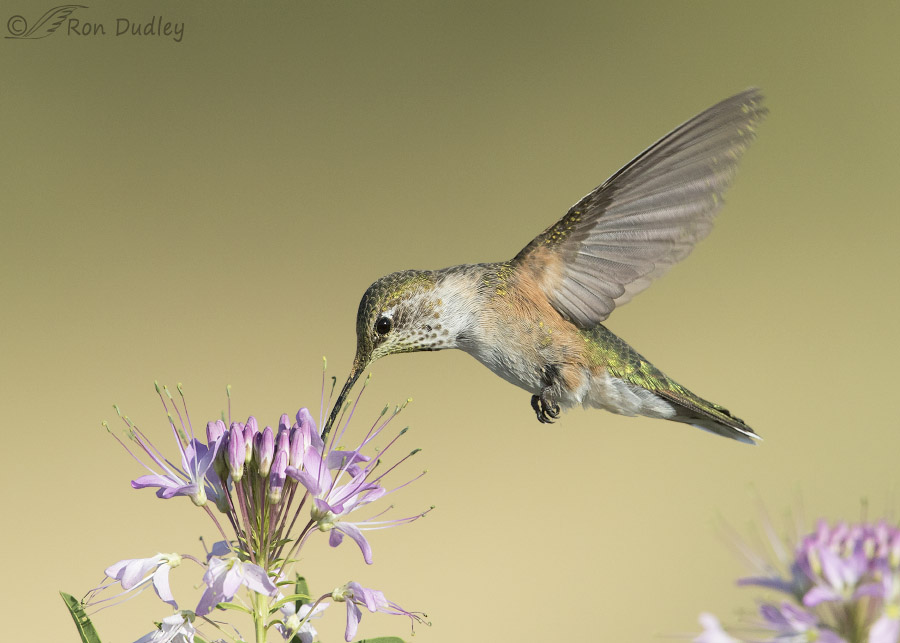These photos really brought home for me the incredible wing speed of hummingbirds.

1/4000, f/6.3, ISO 640, Canon 7D Mark II, Canon EF 500mm f/4L IS II USM + EF 1.4 III Extender, not baited, set up or called in
I photographed this Rufous Hummingbird four days ago as it was feeding on the nectar of wild Rocky Mountain Bee Plant.

1/4000, f/6.3, ISO 640, Canon 7D Mark II, Canon EF 500mm f/4L IS II USM + EF 1.4 III Extender, not baited, set up or called in
This is the next shot in the burst. It’s one of my favorites from the two mornings I spent with hummingbirds (and sphinx moths on one day) at this patch of bee plant. I like the wing position, the clean background and the sharpness of both bird and flower. Looking closely we see that the bill is partially covered with pollen.
Since these were consecutive photos in a burst, at first (and without really thinking about it) I presumed that they were of the same wing-beat cycle (silly me!) – that there had been no beats in-between the two shots. But then I wondered about that and did a little figuring…
My camera fires 10 shots per second in burst mode. According to the National Park Service the average North American hummingbird beats its wings 53 times per second (it’s really more a rotation than a beat which makes that speed even more remarkable). So in the time it took me to fire off these two shots the hummingbird likely completed 5+ beat cycles and I missed 4 of them between the first and second photo!
I find that to be remarkable – partly because the sound of my shutter going off is so fast it reminds me of a firing machine gun so it’s hard for me to visualize that many wing beats between clicks from a bird. If you’re interested in seeing and hearing a burst from my camera in action here’s a clip – the fastest burst starts at about 30 seconds into the clip but the burst rate can be set at different speeds.
And some hummers are even faster – up to 80 wing beats per second for the Amethyst Woodstar Hummingbird. I can’t even imagine ever getting any still images of this little dynamo in flight as it feeds on nectar – it just doesn’t spend enough time at each flower to ever get focus lock on it. I think any bird photographers who watch the second clip will agree (feeding on flowers begins at 32 seconds into the clip).
It’s no wonder we need incredibly fast shutter speeds to get hummingbird wings sharp!
Ron


Ron,
Nice shots. Where were they taken?
Stephen
Ron, I think these shots are amazing and the lesson about Hummingbirds makes me appreciate them even more! Thanks so much…Jer
Fascinating post and beautiful photographs! I’d love to get to see more of these birds. I only see them occasionally in my travels.
Thank you, Joanne.
There are birds all over the world I ogle with green eyes – and hummers are right up there.
Wow! Absolutely beautiful images, Ron. Love how the hummer pops off the background, and all the detail in feathers and wings. It really is incredible how fast those wings move. It would be interesting to see a slow motion video of the wings in motion, to see that rotation you mention. I’ll have to look for that. Hummingbirds are such beautiful birds.
Thanks very much, Todd. I agree – beautiful and athletic.
Human athletes? Eat your tiny, inefficient hearts out.
Stunning images and I am still wrestling with the concept of those missing beats…
And Laura is so right (again) about the magic and wonder in the natural world.
You’re right, EC. They’re in another league than human athletes, that’s for sure!
Sorry to be tardy on this response, but my computer neglected to share several dozen emails with me in a timely manner. DARGH! Computers are EVIL!
Human athletes? Yeah, we’re OK in The Great Out There, BUT I’m continually reminded how inadequate we are overall. I mean, really? In comparison, we’re pretty pathetic in a lot of different areas. Mariah ‘splained that to me a little over 20 years ago and I agree with her. When I look at humans through her eyes, I see just how ridiculous we are–where are our feathers? We’re stuck to the ground (Mariah says, “Sucks to be you!”), we’re comparatively blind and what are those sorry excuses for talons? She also wonders how we get through the day and is continually flabbergasted that I routinely show up with food. Just another perspective
Excellent! Another amazing thing about hummingbird flight is how stable the body is (with respect to the nectar source) despite the rapid movements of the wings. Why doesn’t the body move back and forth or up and down during those rapid wing beats?
Good question, David. There’s so many amazing things going on in those little bodies at any one time that it’s impossible to fathom it all.
Again, outrageously gorgeous images, and like you and Susan said, wrapping my brain around their wing speed is just impossible. I can sometimes get close to it, but then my brain locks up with the wonder of it all and I start spinning in neutral. Just the idea that you could have missed four wingbeats at that shutter speed boggles my little wee brain. Again, I ask my perpetual question, “How do they DO that?” Just another one of Nature’s magics that fill me with wonder and awe! There are so many magics in this world!
“Just the idea that you could have missed four wingbeats at that shutter speed boggles my little wee brain”
Yup, me too, Laura. I try to imagine the physiology of muscles moving that fast and it just doesn’t compute!
Your brain isn’t spinning alone Laura. Some days I think it is where most of my exercise comes from.
NO WAY could you catch that Amethysth Woodstar with a still camera, not a NORMAL still camera!
Maybe in laboratory settings with higher speed camera’s and strobes? The fastest Canon’s / Nikon’s are 14 fps (?), a mirrorless Sony @ 20 fps, 1 Olympus claims 60 fps!
Your shots are stunning as usual, my morning LIFT, that lasts much of the day ;`). That little guy in the video was making me sea sick just trying to follow it, LOL.
It covers the plant so fast it must be responsible for pollinating LOTS of bushes, but I can’t grasp how it gets enough to eat at any one flower?
It seems to just STAB flower and flower ;~)
Thanks again Ron!
Thanks, Alan. Your observations regarding that Amethyst were almost identical to my own!
Yeah. How doe that little thing get enough energy from the flowers to power that speed?
For some reason, I’m really drawn to your first shot with the wings sort of framing its face. It boggles my “widdwe bwain” to think that you missed 5 cycles, especially after hearing the camera bursts. Thank you for sharing the Amethyst video.
Marty, I actually only missed 4 cycles but that’s still pretty darned amazing that there were that many in-between these two shots. One day it would be fun to try to photograph an Amethyst but I’m sure I won’t be going to South or Central America anytime soon…
Beautiful images Ron!
Thanks, John.
The speed of Hummingbird wings, based on what you’ve said and watching that clip, is just mind-boggling. But I can see from that clip how you manage to get so many sharp shots (yes, I know there are a lot that get culled). I can’t wrap my brain around either the speed of Hummingbird wings or the complexity of your camera! Both of these shots are beautiful, but especially the second one.
I have a difficult time “wrapping my brain around” both of those concepts too, Susan – even after all this time behind a camera and photographing birds!
Now that tid-bit of information is very interesting! Hadn’t really thought about camera burst speed vs hummingbird wing speed before, just knew they were fast.
Like your second shot as well, absolutely beautiful! Thanks for sharing.
I hadn’t thought about it much either, Dick. Should have…
WOW! Know the rufus wings are a blur when watching, BUT! Amazing you were able to freeze those 2 frames even after figuring out you misses 5 cycles in between! What we saw of the eclipse (about 90%) from here)was interesting. A good welding helmet got the job done even if the sun was “green”…..
What we saw of the eclipse (about 90%) from here)was interesting. A good welding helmet got the job done even if the sun was “green”…..
Judy, at 1/4000 I think I was right on the edge of having enough SS to get those wings sharp. Since in both shots the wings were either at the top or bottom of the stroke I believe they were a little slower in those positions than they’d have been in the middle of a downstroke or upstroke. Normally for hummers I like to have about 1/5000 sec to give me a little wiggle room.
I remember using welding helmets to look at the sun as a kid on the farm. No eclipses though…
These are beautiful!
I’m glad you like them, Hila.
Awesome shots and very interesting calculations!
Charlotte
Thank you, Charlotte.